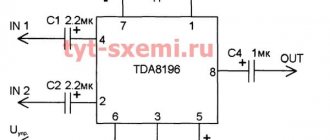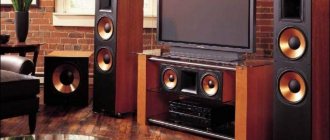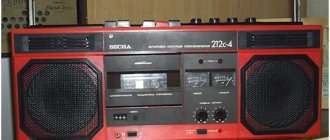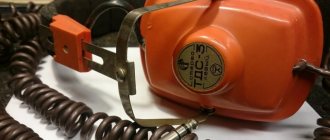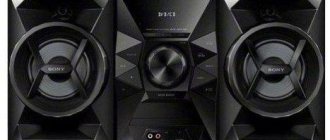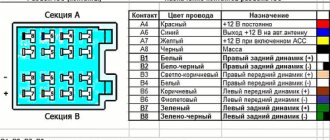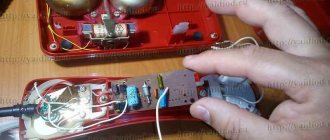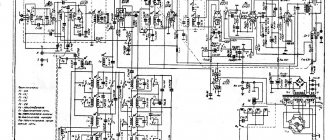Author: Dimon
07 May 2022 22:11
Tags: Music of the USSR interesting nostalgia technology
25869
10
1
The dream of most teenagers in the Soviet Union was a good stereo system. And it doesn’t even have to be imported, because even a good Soviet-made music center cost quite a lot of money. The price of a set consisting of an electrophone, cassette deck and speaker systems reached several thousand rubles. Nevertheless, these centers were willing to buy, let's remember the best of them.
Romance-002-stereo
1
A serious system for serious sound lovers from the Kharkov Shevchenko Plant, produced since 1980. It’s difficult to call it a music center, but it was sold as a set. The presence of a good turntable with a GZM-003 head, a reel-to-reel tape recorder with a full range of functions, a separate amplifier with dial indicators, three-way speaker systems 35AC-202 and even an infrared remote control determined the very high price of the system - 2700 rubles. Moreover, the total weight of the set was more than 135 kilograms!
Description
“Oda-102-stereo” is a stereophonic small-sized radio complex of the first complexity group, made in a block design and designed for operation in stationary conditions. It consists of four functionally complete blocks: tuner, tape recorder, pre-amplifier, power amplifier, made in the same style.
Radio complex "Oda-102-stereo" provides:
- reception of broadcasts from radio broadcasting stations in the VHF band with FM, including reception of broadcasts via a stereophonic broadcasting system with polar modulation;
- playback of mono and stereophonic recordings;
- recording and playback of mono and stereo music programs on two types of magnetic tape placed in a standard MK-60 cassette;
- listening to programs through external speakers or stereo phones;
- playback of programs from external stereo or mono sources.
Sirius ME-325-stereo
0
The influence of Japanese manufacturers of this period is already strongly felt in this center. On the other hand, why reinvent the wheel, especially since the device turned out to be compact and successful. There is a two-speed turntable, a cassette deck with auto-stop and dynamic bias, a five-band equalizer, and two-way speaker systems. The central block weighed 9 kilograms. The complex, called "magnetoelectrophone", even received a commercial on television.
Specifications
Tuner
- 'Range of received VHF frequencies, MHz, not already 65.8…74
- Real sensitivity. µV, no worse... 5
- Noise-limited sensitivity, µV, no worse than 3
- Selectivity in the mirror channel (at a frequency of 69 MHz), dB, not less than 40
- Separation of stereo channels, dB, no less, at frequencies:
- 315 Hz 24
- 1000 Hz 30
- 5000 Hz 24
- Nominal range of reproduced frequencies, Hz, no more than 31.5... 15,000
- Power consumed from the network, W, no more than 4.5
- Overall dimensions, mm, no more than .223x245x75
- Weight, kg, not more than 2.2.
Record player
- Magnetic tape speed, cm/s 4.76
- Magnetic tape speed deviation, %, no more than ±2
- MK-60 cassette rewind time, s, no more than 180
- Autostop activation time, s, no more than . 5
- Detonation coefficient, %, no more than ± 0.2.
- Input voltage for recording: from microphone input, mV, no more than 0.35
- from universal input, mV, no more than 200
- from the radio broadcast input. B, no more than... 15
- Operating frequency range at the linear output, Hz, no worse:
- for tape type I IEC (A4205-ZB)
- in “Fe” mode 40… 12,500
- for tape type II IEC (A4212-ZB)
- in “Cr” mode 40… 14,000
- Harmonic coefficient at linear output, %, no more than — 3
- Relative level of parasitic voltages in the recording-playback channel, dB, no more than -44
- Relative level of noise and interference in the recording-playback channel (for IEC type tape), dB, no more than -50
- Relative level of noise and interference in the recording-playback channel with the noise reduction system turned on, dB, no more than -58
- Frequency response decline of the recording-playback channel at a frequency of 10,000 Hz at a level of -3 dB with the dynamic bias system turned on, dB, not lower than -7
- Relative erasure level, dB, no more than -65
- Mismatch of frequency response of stereo playback and recording-playback channels on the linear output in the frequency range 250...6300 Hz, dB, no more than .. 3
- Output voltage at the output or connection of stereo telephones at a load of 8 Ohms ±5%, mV, not less than 90
- Input resistance for recording, kOhm, not less than:
- microphone input...1.8
- universal input 220
- radio broadcast input 150
- Output impedance of linear output, kOhm, no more than 10
- Overall dimensions of the tape recorder, mm, no more than 223x144, 5x247
- Power consumption, W, no more than 7
- Weight, kg, no more. . 3.5.
Pre-amplifier
- Reproducible frequency range, Hz, no more:
- lower limit . . 20
- upper limit 20,000
- Minimum EMF of the input signal (sensitivity), mV, no more than:
- for line inputs. . 200
- for a correlated input. 2
- Rated output voltage, V. . 1
- Harmonic coefficient in the frequency range 40…16,000 Hz,%, no more than 0.2
- Limits of tone control, dB, at frequencies of 30 Hz.... ± (10± 2)
- 3 kHz ± (3.5 ± 1)
- 15 kHz ± (10+ 2)
- Signal-to-weighted noise ratio, dB, not less than:
- from linear inputs. 70
- from the correction input ... 65
- Signal-to-background ratio, dB, not less:
- from linear inputs 60
- correction input 50
- Transition attenuation between stereo channels, dB, no less, at frequencies:
- 1000 Hz…..40
- 250…10,000 Hz 30
- Transition attenuation between inputs, dB, no less, at frequencies:
- 1000 Hz 50
- 250… 10,000 Hz 40
- Frequency response decline when the “HPF” button is turned on, dB, no less, at a frequency of 10 Hz 10
- Stepwise volume reduction, dB 22± 3
- Loudness compensation effect, dB, when the output signal volume control decreases by 30 dB, not less than:
- at a frequency of 30 Hz. . 8
- at 15 kHz 5
- Power consumed from the network, W, no more than ... 10
- Overall dimensions of the amplifier, mm, no more than 223x245x75
- Weight, kg, no more than 2.
Amplifier
- Reproducible frequency range, Hz, no more.
- lower limit 20
- upper limit ... 20,000
- Harmonic coefficient in the frequency range 40...16,000 Hz,%, no more than . 0.25
- Minimum EMF of the input signal (sensitivity), mV, no more than 1000
- Rated output power, W 10
- Maximum output power, W, not less than ... 25
- Signal-to-weighted noise ratio, dB, not less than ... 95
- Power consumed from the network, VHA, no more than 34
- Overall dimensions of the PA, mm, no more than .223x240x75
- Weight, kg, no more than... 3.4.
Act two.
So let’s continue our theme, the theme of “Ode”, but not that “Ode-101”, but the other “ Ode 102 Stereo”
, having not received the coveted profit from his first “brainchild” “Oda-101”, as expected, he changed tactics according to the military. Oda 102 Stereo was born , it became both more beautiful and cheaper, and it began to please the buyer’s eye and stopped emptying the wallet, like its older sister. But first things first. And armed with a rock climber, forward to the top. The first block, as expected, is a power amplifier (PA), the circuitry, as expected, has undergone a change, what? Yes, that’s it, it has become simpler, but retained the characteristics. The most important thing is that the protection algorithm has been preserved. Let's continue climbing. The next block is the preliminary amplifier (PA). Here, of course, you can cry and there is a reason for it. Everything was cut out of this “organism”, turning it into the most mediocre apparatus. Ask what? My answer is that the microphone amplifier was removed, two bands were cut off from the equalizer, the amplifier and corrector removed its screen, and the inductors in the equalizer circuit were removed. So UP has become miserable, I feel sorry for it, how well it all started. We cried and that's enough. Above we see a VHF receiver, in principle it has become prettier, but the charm has been lost. A simple vernier mechanism “pushes” an electronic scale with a moving LED. But on the other hand, I purchased an interesting LED indicator for fine tuning, which works very nicely. The receiver blocks remained standard. You think that I forgot about the columns, no, I remember and the topic of the columns is interesting. Well, we all got to the top, to the tape recorder. The Oda-MP302 tape recorder is an interesting thing, ask what, but what, the developers of this box pursued, I think, two goals. The first goal: it is more convenient to install the tape recorder first in the rack, or whatever is more convenient, as we see, “Oda-101” did not allow this to be realized. Second goal: tape drive functionality. Having plowed the vast expanses of our vast country, the developers went to ask for currency to purchase a foreign miracle. And in order not to lose face, having studied experience, the choice fell on the LPM of the Hungarian BRG plant. The kinematics turned out to be marvelous, completely plastic and, think about it, on gears. In the understanding of a Soviet person, a gear in the kinematics of a tape recorder is impossible, it is a roar and a grinding sound. But no, the Hungarian mechanism worked quietly because it was cast from special plastic on precision dies. That's not all, upon closer examination we see some three letters hitherto unknown to SDP. What is it, this is a switchable dynamic magnetization system, which improves the recording of high frequencies. Well, that’s all, we’ve sorted out Oda-102, but not quite, I promised you a tour of the speakers. So, the first 15-AS213 speakers were also metal, like those of Oda-101, but the “labyrinth” type bass reflex was replaced with a classic one, and one high-frequency speaker was also removed, of which there were two in Oda-101. Then the plant switched to completely plastic speakers. Summarizing what has been written, the technology for making the Oda-102 complex cheaper can be clearly seen. And then what the plant was going for happened, the kit was very readily sold out.
Continuation.
Well, there is no currency, the Hungarian tape drives have run out, but somehow we need to fulfill the five-year plan, and again the Murom developers temporarily became search engines. And again fortune helped them, they found the Ramensky mechanisms. And “Ode to RMED-201-2” appeared. But in Murom the specialists were sad, ask why, I will answer. The Ramen mechanics turned out to be so capricious that it led the developers to despondency. The cause of the failures was the “software gear”, because of it the mechanism did not work correctly, and the modes specified from the control buttons simply did not turn on. And this device did not reach the retail chain, so that there would be no 100% complaints. No alternative to it (the mechanism) was found, and the nineties were approaching. Sadness.
Ode 102 SVR.
Muromsky released another model for the mountain. And it’s called, (drum roll), “Oda-102SVR”, model 1997. This model lost the amplifier in two blocks (UP) and (UM), it became a complete amplifier, “Oda U-102”, also known as “Oda U-202”, no fundamental differences in circuit design were noticed, only the magnetic pickup corrector was soldered on the preliminary board amplifier, as usual, having forgotten to shield it. The tape recorder in this configuration was still on the same Ramenskaya mechanics, but they forgot to sponge the VHF receiver. As was customary in those years, Russian buyers no longer discovered this “Ode” on dusty store shelves. The speakers remained the same 15 AC-213.
ODE TO A MASTERPIECE.
As the title suggests, we will talk about a masterpiece, and this masterpiece of the Soviet radio-electronic industry was created by the designers of Muromsky. I would cast bronze busts of these geniuses during my lifetime. Many years to you, dear geniuses.
So: “Ode to REMD-201” I only ask you to love it, don’t complain about it. Well, off we went, in 1988 “Ode to REMD-201” was born, the first and only and brilliant and..... jammed, you need to write specifics. The birth took place without pathologies, a child prodigy was born, I will describe in detail my train of thought and even more. In principle, having examined this device from about ten meters away, even an experienced expert in the field of radio equipment will probably say the following, well, I see two “pockets”, that is, a tape recorder, I see a vinyl record player, I see a receiver scale. It’s impossible to disagree, he’s right. But as soon as you come within arm's length and take a closer look, everything immediately changes. The recording keys on both tape recorders evoke unearthly delight; this is not found in Soviet two-cassette recorders and is not found in foreign ones. It’s so creepy, but how relevant it was. Having taken a record for one hour, it was possible not to record it on one tape recorder, for a simple banal reason - a defective cassette, "Oda-201", having recorded the record simultaneously on two cassettes, guaranteed you a high-quality phonogram. I was pleasantly surprised by the function of listening to two tapes at the same time, why? And that’s why, on the first cassette I have text, on the second there is quiet music, together the text against the background of music is cool. Now here's a powerful bomb. I ask everyone to go down to the bomb shelter. “Oda REMD-201” has “selector memory” buttons, what is it, and here’s what. Let me give you an example, I wanted to record a vinyl record on the first tape recorder, for this I put it on the disk and turn on the first tape recorder to “record”, by pressing button one of the selector memory I switched this chain and the first tape recorder was firmly “attached” to the player. At the moment I decided to listen to the receiver, and there was a good concert, I press the “record” key on the second tape recorder and button two “selector memory”, now the second tape recorder is “linked” to the receiver. But that’s not all, I can now listen to both the record and the receiver and an external source, and my tape recorders record only from the sources to which they are “linked”. This is the music box. There is no such marvel in the whole world.
Third act.
The character is "Oda-102", but not that one, but with a new tape recorder "Oda-MP303". As I wrote earlier that I purchased magnetic tape strips for foreign currency, they began to save this same currency. The faucet from Hungary was tightened, putting the designers of this complex in the pose of bloodhounds. And they found a way out, what a way!!!!! “Oda-102” received a Soviet-made electronically controlled tape drive. HOORAY. One might as well think about a “lazy guy”, for those who don’t understand, I’ll explain, this is a remote control. But alas, in those distant years there were no remote controls, it’s sad.
